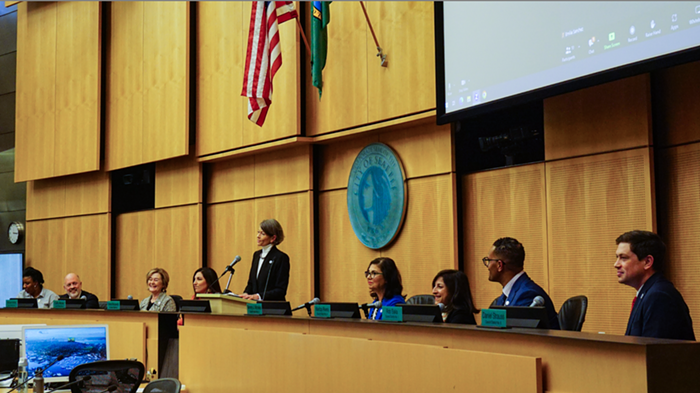
On Monday afternoon, Mayor Ed Murray announced new details about how an outside panel of experts will review the ongoing replacement of the Elliot Bay Seawall, which is expected to be delayed by at least a year and cost $71 million more than originally planned. Soon after Murray's announcement, city council members grilled the Seattle Department of Transportation about what the hell happened and how they planned to better communicate with the council about what happens with the project going forward.
News broke last month that the project would run over budget because the cost of jet grouting for the project was costing the city more than anticipated. As SDOT explains jet grouting, it's the process of injecting grout into the soil in order to create columns of "stabilized soil" that provide a solid foundation for the seawall. (The old seawall used 20,000 old growth timbers.) Getting rid of the waste created by this process is turing out to be more expensive than anticipated. SDOT says traffic and water management are also significant drains on the project's budget.
SDOT also opted for a fancy process of freezing the ground at the seawall (Remember this? Charles wrote about it in February) instead of a cheaper traditional dewatering method. Why? According to SDOT, the freezing technique costs more upfront but traditional dewatering was more likely to have expensive side effects, like the ground sinking we've seen around the tunnel. The department dipped into its contingency funds for this technique, SDOT representatives said Monday, which means they have less left in that fund now for these new costs.
Last month, the mayor said the city would use real estate excise tax funds and bonding against the commercial parking tax to pay for the increased costs. On Monday, the city's budget director and SDOT staff broke down the numbers. Over the next two years, the city will cobble together the $71 million in extra money needed for the seawall project from several sources: $45 million from bonding against the parking tax, $23.1 million in revenue from the real estate tax, $2.1 million in parking fees on the waterfront, and $.8 million from the city's waterway fund of fees charged on commercial boats and ferries.
According to the mayor's office, the money from the real estate taxes and bonding against the commercial parking taxes is currently not budgeted for anything else. But city budget director Ben Noble said Monday that the new funds being redirected to the seawall project "would have been dedicated to other transportation needs," but called replacing the seawall the city's "highest safety priority… addressing a seismic risk to all of downtown."
Currently, much of the seawall replacement is being funded with a $290 million voter-approved bond measure. The total cost has risen over the years from $300 million to about $339 million and now to about $410 million.
The mayor said last month an expert panel would review the seawall project. On Monday, he elaborated on that plan, saying the city will spend $200,000 to hire a consultant and convene a group of "peer agency experts, such as public works directors and chief engineers, with broad experience in large-scale public works construction and in-water construction." SDOT director Scott Kubly said Monday the mayor and council will jointly choose who sits on that panel and that he hopes its review will be done by December. The group will review the project's budget, contract, design, and schedule and make recommendations about ways to lower the costs and risks of the project.
Work that was supposed to start October 1 on the next phase of the seawall project (between Pike and Virginia Streets) will be delayed until late 2017. In the meantime, his department will consider renegotiating contracts already in place, rebidding parts of the project, and other efforts to try to find ways to save money on the remaining seawall work. In that process, there is "literally nothing that's off the table," Kubly told the council.
Throughout the meeting Monday, council members, especially Tom Rasmussen, were openly skeptical of SDOT, questioning whether there was some way the department should have known in its planning process that the project would cost as much as it now looks like it will. The project had previously been a point of pride for the city administration. In contrast to the shitshow of the Washington State Department of Transportation's tunnel project, the seawall was moving along on budget and on schedule.
"Frankly, I thought we were getting good reporting earlier," said Council Member Jean Godden, who added that SDOT told the council on April 13 that the project was on time and on budget. "So, it's kind of blindsiding to discover we have not been there."
Council Member Sally Bagshaw was more generous.
"This is an extraordinarily complicated project," Bagshaw said. "I haven’t heard anything today that makes my hackles go up... [or indicates] that anybody has tried to pull the wool over our eyes."
Kubly and others from SDOT said they'll have a new plan for how to communicate with the city council in the coming month.
"It is and continues to be a high-risk project," said SDOT's Jessica Murphy, who's helping oversee the project.


















